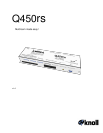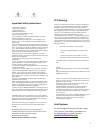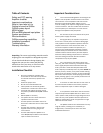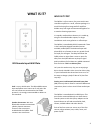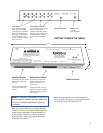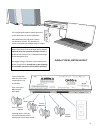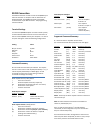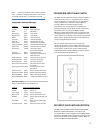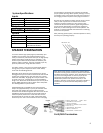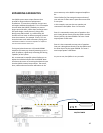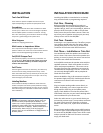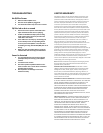3
Table of Contents
Safety and FCC warning 2
Amplifier checklist 3
Important considerations 3
What is it and who is it for 4
Getting to know the Q450rs 5
Q450rs system layout 6
MR44 keypad 7
BIX and BIB balanced input plates 8
System specifications 8
Wire terminations 9
Q450rs expanding capabilities 10
Installation procedure 11
Troubleshooting 12
Warranty Information 12
Unpacking: The carton and packing materials used in
shipping your new amplifier are designed to protect
it from shock and vibration during shipping. We
suggest that you save the carton and packing
materials to use if you move, or if the unit ever
needs to be returned to us for any reason.
Installation Checklist
Plan your installation. Consider what
sources will be used and make provisions
for infrared and sources, speakers and
cabling.
Collect the proper tools.
Run all wires and label both ends.
Install speakers as directed by speaker
manufacturer. Test wire for short circuits.
Terminate cat5 and test for short circuits
and polarity for MR44 and BIX/BIB modules.
Retest.
Mount Q450rs if necessary.
Test speaker wire for shorts and correct
impedance with ohm meter.
Connect speakers. Note which zone is for
which room and which source is from which
location.
Connect cat5 connectors. Ensure cat5
keypads and sources are going to the
correct socket.
Connect audio outputs to Q450rs or to
‘local’ BIX/BIB inputs. Make a note of which
input is used for each source.
Important Considerations
Test all installed cabling before connecting to the
Q450rs. Test the speaker and wires with a multi-meter
set to ohms for correct impedance and short circuits.
Resistance and impedance differ slightly so a very
accurate reading is not expected. Long speaker wires will
increase resistance. This also includes cat5 connectors.
Incorrect polarity of a twisted pair can cause serious
damage to the Q450rs and its peripherals.
Do not make any wire connections of any kind
with the power supply connected.
During operation, the amplifier may become
warm. This is normal; there are instances during high-
level playback into low impedance speakers when the
amplifier will become much warmer than usual. To
ensure the amplifiers trouble-free operation, it is
necessary to provide adequate ventilation. Keep the
amplifier away from external sources of heat such as
radiators and hot-air ducts. Never place the amplifier
with other heat-producing components in a cabinet or
enclosure lacking free airflow. Do not stack other
components on top of your Q450rs.
Care, maintenance, and cleaning: wipe with
clean, dry, soft cloth. If necessary, first wipe the surface
with a slightly dampened soft cloth with mild soapy
water, then with a fresh cloth dampened with clean
water. Wipe dry immediately with a dry cloth. NEVER use
benzene, thinner, alcohol, or any other volatile cleaning
agent. Do not use abrasive cleaners, as they will damage
the finish of the metal parts. Avoid spraying insecticides,
waxes, polishing agents, or any aerosol product near the
Q450 or any of its components.
It is best to run extra cat5 wires to each room as
this will make the installation more future proof and
offers an inexpensive repair if a cable is damaged.
It is important to know where the various wires
required to operate the Q450rs will be run. Never run a
cat5 or speaker cable parallel to a high voltage AC mains
cable. This may cause problems with the operation of
Q450rs. If possible don’t locate a keypad next to a light
switch for the same reason.
The Q450rs needs to be a safe distance from any
large AC motors, including an air conditioner, or
fridge/freezer, or breaker panels as this can cause
unwanted interference.



